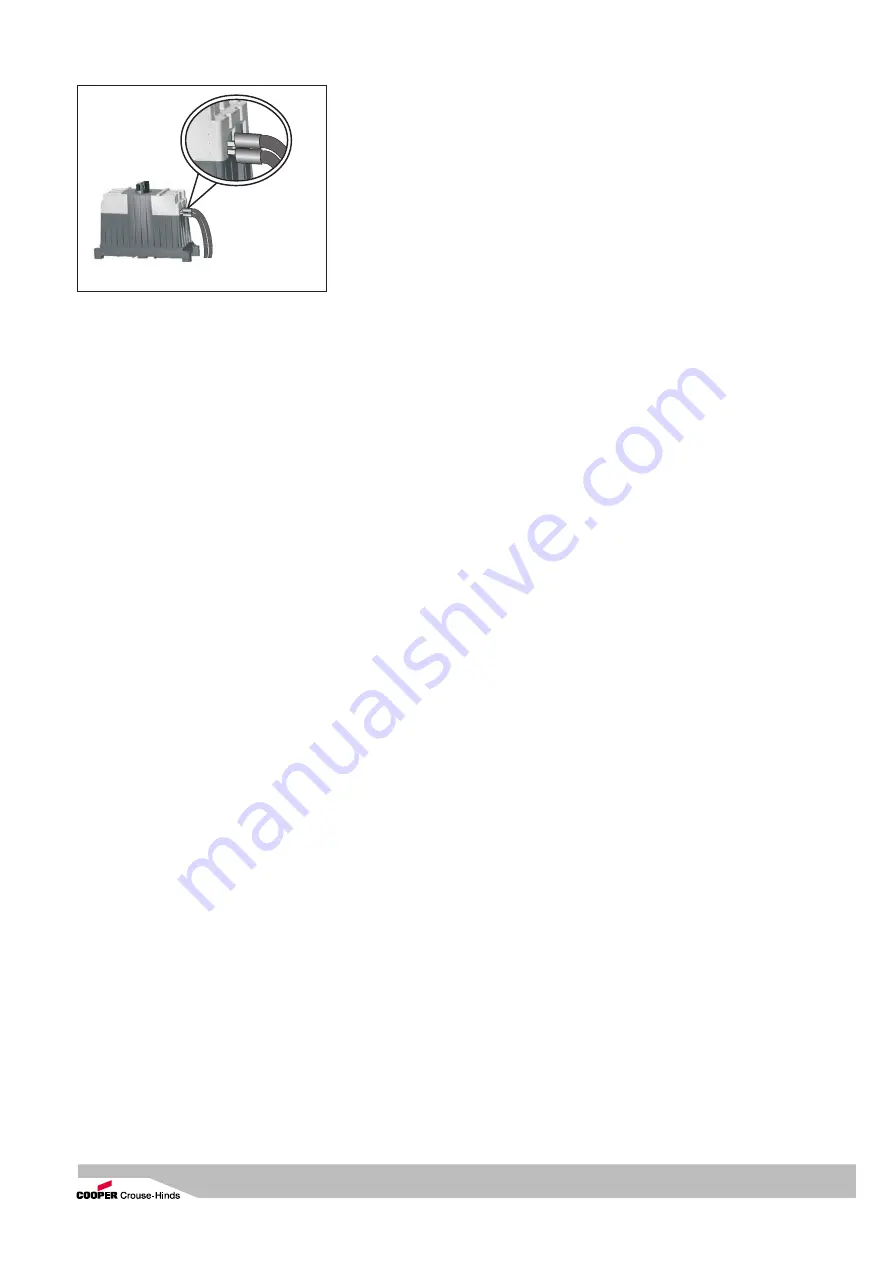
Cooper Crouse-Hinds GmbH
77777
Flameproof module series, GHG 62. .... R....
6
Mounting
Before mounting the modules, it is necessary
to check them to ensure that they are in
perfect condition. Special attention shall be
given to any possible transport damages
(cracks and damage to the flameproof
encapsulation or any other damage to the
modules).
The modules can be mounted by snapping
them onto a DIN rail or screwing them onto an
internal mounting plate (Test torque 2.5 Nm).
When mounted directly onto an internal
mounting plate, the enclosures shall be fixed
in such a way that they rest evenly on the
fastening points provided for this purpose
and that they cannot turn.
6.1
Electrical connection
The electrical connection of the apparatus
may only be carried out by trained staff.
The properly bared conductors of cables
shall be connected with due regard to the
respective regulations.
To maintain the explosion protection, con-
ductors shall be connected with special care.
The insulation shall reach up to the
terminal. The conductor itself must not be
damaged.
The minimum and maximum connectable
conductor cross sections are to be
observed.
Two conductors with pin lugs in one terminal,
have to connect as in Fig.2 shown.
All screws and/or nuts of the connection
terminals, including those not in use, shall be
tightened down securely.
The built-in standard terminal is designed for
the direct connection of conductors with
copper wires.
The circuit diagram of the built-in components
is shown on the modules, included with the
switch unit or included in the operating
instructions. In the case of wired installations
or distributions, the connection diagram
included with the apparatus shall be
observed.
When using multi- or fine-wire connection
cables, the wire ends shall be treated in
accordance with the valid national and
international regulations (e.g. use of cable end
sleeves).
8
Repairs / Modifications
Only original COOPER CROUSE-HINDS
GMBH parts shall be used for carrying out
repairs.
In the event of damage to the flameproof
encapsulation, replacement of the
respective components is mandatory. In
case of doubt, the respective apparatus
shall be sent back to the manufacturer for
repair.
Apparatus modifications or design changes
are not permitted.
9
Disposal / Recycling
The respective valid national regulations for
waste disposal shall be observed when
disposing of apparatus.
To facilitate recycling of individual parts, parts
made of moulded plastic shall bear the
marking for the type of plastic used.
The product range is subject to changes and
additions.
6.2
Putting into operation
Before putting the apparatus into operation,
the tests specified in the individual national
regulations shall be performed.
In addition to this, before being put into
operation, the correct functioning of the
modules shall be checked in accordance with
these operating instructions and other
applicable regulations.
The incorrect installation can result in the
invalidation of the guarantee.
7
Maintenance / Servicing
The valid national regulations for the
servicing / maintenance of electrical
apparatus for use in potentially explosive
atmospheres shall be observed the
EN 60079-17 and EN 60079-19.
Prior to opening the enclosure, it is
necessary to ensure that the voltage
supply has been isolated or to take
suitable protective measures.
Only original Cooper Crouse-Hinds GmbH
spare parts may be used!
The user is responsible for stipulating the
necessary maintenance intervals specific
to the application depending on the
conditions of use, national directives and
standards.
Should the maintenance interval for the
function test of an RCCB/RCBO not be
defined, the manufacturer of the RCCB/
RCBO recommends to test the function
by the test button twice yearly.
The RCCB/RCBO shall release when the
test button is actuated. If this is not the
case, the protective function is no longer
guaranteed and the RCCB/RCBO shall be
replaced.
During servicing, above all the correct
working order of parts on which the explosion
protection depends shall be checked.
If, in the course of servicing, it is
ascertained, that repairs are necessary,
section 8 of these operating instructions
shall be observed.
Fig 2
probability of its being fatal is reduced to a
negligible value.
The manufacturer of the RCCB/RCBO
recommends to test the function by the
test button Fig. 1, Item 1, twice yearly.
A signal contact (optional) on a RCCB/RCBO
is actuated by an overload, earth fault or
short circuit. It cannot, however, be tripped if
the circuit breaker is switched manually.
When special switch or control units are
flameproof-encapsulated in these module
enclosures, details relating to the properties
and use of these modules shall be taken from
the respective supplementary sheet.
The data according to sections 3 and 4
shall be taken into account during use.
Applications other than those described
are not permissible without a written
declaration of consent from the
manufacturer.
During operation the instructions stated
in section 7 of the operating instructions
shall be observed.
The sole responsibility with respect to the
suitability and proper use of these
modules lies with the operator.
The screws used shall match the fixing hole
(see dimensions drawing) and shall not
damage the hole (e.g. use of a washer).
If the fixing screws are overtightened, the
apparatus may be damaged.





















